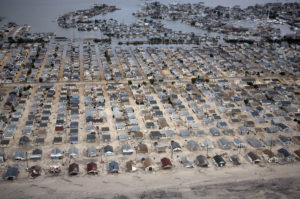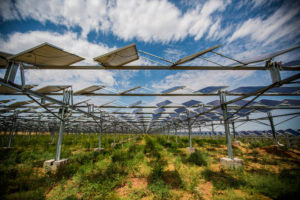“We can now safely say that 1.5 is the new 2 degrees.”
This was Christiana Figueres’ upbeat response to the US climate summit. The former executive secretary of the UN Framework Convention on Climate Change (UNFCCC) was referring to the target agreed by countries under the Paris Agreement to keep global temperature rise “well below” 2C above pre-industrial levels, with 1.5C as an aspiration – despite scientists advising a maximum of 1.5C to prevent runaway climate change.
While multiple new commitments announced by governments at the climate summit would not guarantee the lower figure, they are enough to keep the possibility alive, she said. “1.5C has now taken centre stage. We did not have that before the Biden summit,” she said.
More than 40 heads of state from a mix of major developed and developing economies and poor, climate-vulnerable countries attended the virtual summit at the end of April.
New targets
The US got the ball rolling with its target to cut emissions 50-52% by 2030, compared to 2005 levels. The commitment received high praise, representing a near doubling of its previous pledge, and sending a clear signal that the Biden–Harris administration wanted to make up for time lost under climate sceptic Donald Trump.
Several countries also made significant announcements: Canada will target an emissions decrease of 40-45% by 2030 (compared to 2005); Japan said it would cut emissions by 46% by 2030 (compared to 2013); while South Africa said it will bring forward by a decade its plan to peak emissions – from 2035 to 2025. Ahead of the summit, COP26 host the UK announced a new carbon reduction goal for 2035 of 78% from 1990 levels, which will include aviation and shipping for the first time.
South Korea committed to halt permits for new domestic coal plants. Significantly, it said it would also end public finance for overseas coal-powered plants. The country is the third biggest public backer of these among the G20, with about US$10.7 billion invested between 2009 and 2020, according to Greenpeace. The remaining public funders of coal plant construction worldwide are now Japan and China, both of which have also indicated intentions to end the practice.
China pledged to “strictly limit” increases in coal consumption between 2021 and 2025, and phase it down over the following five years. Byford Tsang, senior policy advisor at think-tank E3G, said China had been careful not to make announcements that could be seen by domestic audiences as caving to US pressure. “China is more likely to make big commitments in a more multilateral space, such as those the UN convenes,” he said. The commitments made at the Biden summit, combined with those announced since September last year, have narrowed the 2030 “emissions gap” by around 11-14% (2.6-3.7 GtCO2e), according to analysis by Climate Action Tracker, with the largest contributions coming from the US, the EU+UK, China and Japan.
What is the 2030 emissions gap?
The difference between projected emissions levels in 2030 and levels that would be consistent with staying within the 1.5°C warming limit of the Paris Agreement. Each year, the UN Environment Programme releases a report on progress towards (or regress from) the goal.
The summit also saw the launch of the LEAF Coalition, a group of governments including Norway, the UK and US, and companies that will provide financial support to tropical and subtropical countries to reduce emissions from forest loss and degradation.
Other countries disappointed, however. Brazil re-committed to zero illegal deforestation by 2030 – a target originally presented at COP21 in 2015 – and said it anticipated emissions neutrality by 2050, rather than 2060.
But these commitments did not touch the drivers of deforestation in the country, said Natalie Unterstell, director of Brazilian think-tank the Talanoa Institute. Though Brazilian president Jair Bolsonaro had shifted his tone in front of the international community from attack to defence, this stemmed from a growing pressure around climate issues in the months since Biden’s election, she observed. “That does not mean that Bolsonaro is changing direction on environmental issues, mainly because his political allies benefit directly and indirectly from current deregulatory policies,” she said.
Words, words, words
Alden Meyer, senior associate at E3G, said that the diplomatic leverage of the US could be seen in the moves by Canada, Japan and South Korea. However, he accused others including Australia and Russia of “gaslighting”, or talking about climate action in a way that was totally at odds with their domestic policy.
“One of the tests for the US and other countries going forward is how you expose that disconnection between the rhetoric and the reality of countries – we need to figure out stronger accountability strategies around some of these countries,” he said.
The US did not have much leverage with countries such as China and India, Meyer said, suggesting it would have to team up with the EU and UK in the run up to COP26 to make inroads there.
Campaigners were critical of the lack of discussion of finance at the summit. Though many leaders did acknowledge the need to increase finance, and to meet and exceed the $100 billion commitment for financing developing countries from 2020 onwards, there were no significant commitments made apart from by the US, which signed up to deliver $5.7 billion per year by 2024 – a doubling of Obama-era financing.
There were also no financial commitments to adaptation or compensating for the unavoidable consequences of climate change known as loss and damage. Concrete commitments on these issues will be key ahead of COP26 to win support from poorer countries, who argue they will suffer the biggest consequences of climate change, despite being the smallest contributors.
Rueanna Haynes, senior legal advisor and support team lead for the Alliance of Small Island States at Climate Analytics, noted the silence on loss and damage from the US, despite the White House framing their assistance to vulnerable countries in the context of climate justice.
The road to Glasgow
The summit was one in a series of diplomatic events in the run-up to COP26 in Glasgow in November. Climate ministers will meet virtually in May for the Petersburg Climate Dialogue, where finance is expected to be discussed.
Climate action will also be on the agenda at the G7 meeting in June, to take place in the UK, and October’s G20 meeting in Italy. Informal talks under the UNFCCC will be also be held over three weeks in June, though they will be online due to the pandemic.
Questions have been raised about whether COP26 will need to be delayed again. The UK government says it is still planning for the final COP in November to be held face-to-face, despite surging rates of Covid-19 around the world.
Online negotiations for the final COP will be unacceptable to many people, not least in developing countries, where they fear being put at a disadvantage by poor quality internet access. The UNFCCC says it is supporting logistical and connectivity needs for participants in the June meetings, and scheduling meetings to accommodate different time zones.
Speaking at a webinar hosted by the Clean Energy Wire journalism network, UK lead negotiator Archie Young said the UK recognised “the urgency and need” for an inclusive process. “We are working closely with the UNFCCC, public health officials, and the Scottish government to explore how we can have the event in-person, while using technology to make the COP as inclusive as possible, and making contingencies.”
The first of May marked exactly six months till the start of COP26, in whatever form it takes. Biden’s summit jump-started higher ambition, and upcoming global meetings will tell if all governments are getting into gear.









